Photos with this report (click to enlarge) | |||
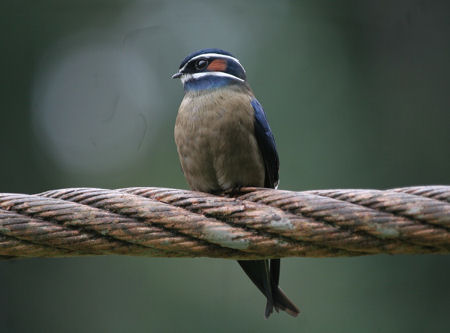 Whiskered Treeswift |
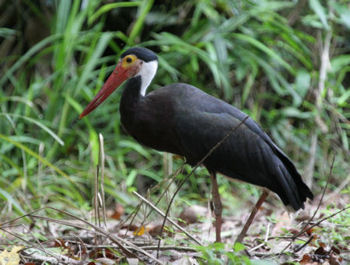 Storm Stork |
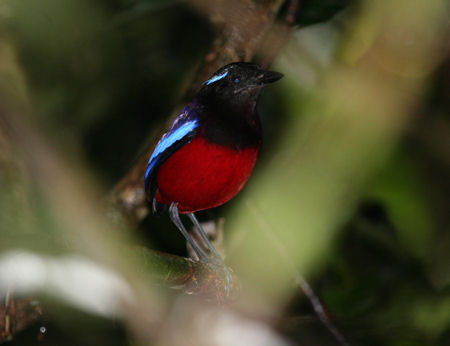 Black and Crimson Pitta |
|
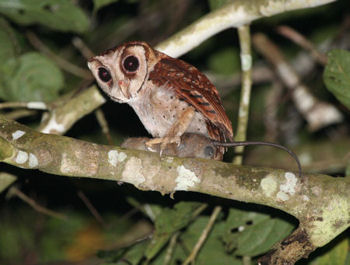 Bay Owl |
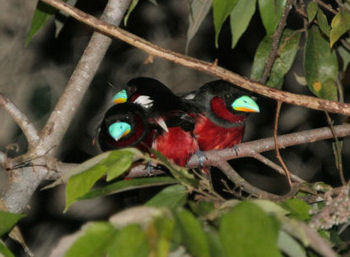 Black and Red Broadbill |
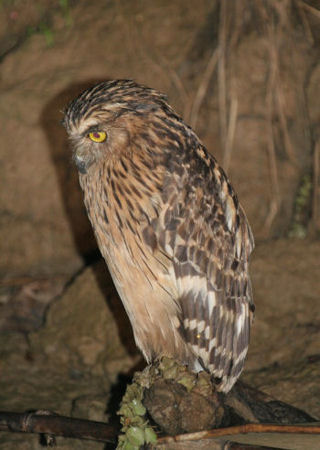 Buffy Fish Owl |
|
INTRODUCTION
The Malaysian part of Borneo (Sabah) was next on our south-Asia trip list, after Thailand and Cambodia, with the objective of seeing as many endemics as possible. We concentrate our trip on 3 sites : Mount Kinabalu National Park (MKNP), Lower Kinabatangan River (LKR) and Danum Valley at the Danum Valley Field Center (DVFC).
We decided to hire a car rather than using local transport , taxis and the cheap internal flights of Malaysian Airlines. We took this decision to avoid any “connection difficulties” and to have as much flexibility as possible. As all the sites are not too far from Airports, using internal flights is surely a good option. There are airports at Kota Kinabalu (close to MKNP), Sandakan (not too far from LKR) and Lahad Datu (The DVFC organizes transport from Lahad Datu). Robert Chong (see contact below) can arrange transport form Snadakan to LKR.
Car Rental is a problem but we did find a fair price with John Nair [nair_john@yahoo.com] who rent us a Proton Wira for RM120 per day with insurance. Quotation with “classical” rent-a-car society is around double. His phone is : +601 981 121 17.
CONTACTS
Contacts were made directly :
At Lower Kinabatangan River (LKR) with Robert Chong
“kinabatangan jungle Camp”
labukbb@yahoo.com
Mobile 019-804-7756
At Danum Valley Field Center (DVFC)
On the website :
http://www.ysnet.org.my/Maliau/index.html
Prices for rooms are on the website, but the reservation page was not functioning while preparing my trip and I had to phone directly to Susan (She is the right person to contact)!. Her direct line is : 089 880441.
We did not go the extortionate Bornean Rainforest Lodge, as birds are more or less the same at DVFC (except for the pygmy white eye!!). They asked 1050 $ for 2 night for 3 persons and an additional 55$ per day for Wangkong’s service. If you are willing to go to BRL check the web site.
http://borneorainforestlodge.com/reservations/ or phone at the reservation office ++618-529-8033
At Mount Kinabalu National Park (MKNP)
Direct reservation is possible through the web site :
http://www.suterasanctuarylodges.com/
There we stayed 2 nights at the Head Quarter (HQ) and one night at Laban Rata (LR). LR lies below Mt Kinabalu at 3300 m above sea level, and is the place where climbers spend the night before making it to the summit the next day. It is therefore advisable to reserve in advance there. It is also the safest way to be at first light at the right spot for the “un”Friendly Bush Warbler. The above-mentioned web site is also the link for reservation at Poring Hot Spring (PHS).
At Kota Kinabalu
At Kota Kinabalu, we stayed at the Daya Hotel (tel : 60-88-240000) recommended by John Nair. We found it clean for a reasonable price, and well situated in the centre of the city. For more infos, check the website :
http://www.kkdayahotel.com
REFERENCES
Books
A field guide to the birds of South-east Asia. Craig Robson. 2000. New Holland
A field guide to the birds of Borneo, Sumatra, Java and Bali. John Mackinnon and Karen Phillipps. 1993. OUP. Essential
Where to watch birds in Asia. N Wheatley. 1996. Christopher Helm.
Report on a birding trip to Sabah; March 30th- April 21st 2001. Andrew Duf, John Geeson, Judy Geeson, Ann Lawson. OBC.
Field guide to the mammals of Borneo. Payne, Francis, Philipps (Revised 1994).
Additional (facultative)
A Photographic Guide to the Birds of Mt Kinabalu, Borneo by Hitoshi Nakayasu, Shigeru Asama and Alim Biun. 1996.
Recordings
Birds of tropical Asia 3 by Jelle Sharringa. This 3d Edition has many endemics of Borneo. ESSENTIAL ! Some species are unfortunately not on this DVD. I ordered at the Library Sounds a few additional recordings (Blue-banded Pitta, Bornean Barbet, Bar-headed Laughinthrush, Bornean Wren Babbler and Bornean Blue-flycatcher). The website is :
http://cadensa.bl.uk/uhtbin/cgisirsi/Mon+Jan+15+14:52:42+GMT+2007/0/49
I paid 21 pounds + VAT for 6 recordings.
AKNOWLEDGMENTS
Many thanks for their help to James Eaton, Peter Chong, Filip Verbelen, Tipp Cheryl, Rebecca Lee, David Bakewell and Ak. Mohd. Rodzan PG. Dahlan. A very special thanks to Ward Vercruysse for his help and for the very usefull tape recordings he provided. Also a great thanks to Georges Wagner, a keen American birdwatcher, we enjoyed to meet at Danum.
STRATEGY
It is difficult to balance adequately the trip between the three main destinations : LKR has the mega-target (the Bornean ground cuckoo), while Danum (DVFC) is one of the hardest birdwatching place in the world deserving a lot of time and MKNP hold a lot of endemics you would not want to miss.
Therefore we devoted 2 nights/3days at LKR with Robert Chong, 4 nights at Danum, and 4 nights at MKNP (including one night at Laban Rata for the Friendly Bush warbler). I would recommend, while at DVFC, to contact Wangkong Intal (local Pitta tracker) as I heard he might meet you at DVFC, coming from BRL (Bornean Rainforest Lodge). We did not stay at BRL.
The cost at LKR was 880 RM per person for a complete 2days/2night package at Kinabatangan Jungle Camp (KJC), all meals included, 5 boat cruises, and personal guiding with R. Chong. This rate included transportation form Sepilok area to Kinabatangan, but did not include an excursion to Gomantang cave. The road to Kinabatangan is being upgraded and we made it with our proton wira.
From Lahad Datu, we did not try the unsealed but well maintained private logging road to DVFC, although we could have make it with our proton wira (but the weather is always uncertain at this period of the year!). We instead payed 600 RM for return trip arranged with DVFC Office (situated next to the Airport) . On mondays, wednesdays and fridays, regular DVFC transport are available at cheaper rate. Check also their website for more informations on Conservation/fee permit, resthouse accommodation, Full-board, etc…
MKNP has rather cheap accommodations you can fix (reservation/payment) directly on their website (including the night at Laban Rata). After payment, they will send you a “reservation code” you will need to recall while getting there. It worked perfectly, but bear in mind that Mount Kinabalu is a well-known holiday destination. It is therefore advisable to reserve weeks in advance. While there, I recommend a cheap restaurant, outside the park just in front of the Entrance. The Liwagu restaurant, inside MKNP has good food but expensive beer (18 RM each!!).
THE TRIP
We arrived on friday, 16 march at 12h00 at Kota Kinabalu International Airport, met John Nair for the car reception, and headed directly to the jetty behind the Kinablau Golf Club, close to the Tanjung Aru Shangri-La’s Resort, where we jumped in a boat for Pulau Manukan (ride available every half hour). We walked the joggers path (ask one of the “ranger” for the entrance of the path) and soon encountered our first targets : Tabon Scrubfowl, Mangrove Whistler and Mangrove Blue-flycatcher were all cooperative.
On our way back, among the common Green Imperial Pigeon, we spotted 4 flying pigeons almost surely Nicobar !!
Back to Kota Kinabalu, after adding a few new birds during the boat ride (Whiskered and Great Crested Terns, White-bellied Sea Eagle), we decided to try the Chinese Egret at Likas bay. No luck again, after dipping it in Thailand and China, this mythical egret eluded us again here !! the only bird of note was a fine Pied Triller among the commoner species ( White-breasted Wood Swallow, Chestnut Munia, Common Iora, Black-crowned Night Heron, Purple, Striated and Pacific Reef Heron, etc…). The Chinese Egret is apparently present in the basin with wooden house on piles behind the moslem mosque only at low tide. It is rarely seen on the beach.
We arrived at Poring Hot Spring around 22h00, just time for some beers before they closed the centre at 23h00.
The chalets and hostels were all full. It is therefore advisable to check and reserve well in advance.
On 17 march we started early for a long ride to the Langanan Waterfall. Birding was slow with little of note on the way up, except for a nice Banded Woodpecker. No Pitta were calling. After the second river crossing, around a clearing, we found a good fruiting tree with some welcomed sightings : 2 Red-bearded Bee-eaters, the “orange throated Bornean race” Brown, Gold-whiskered, Blue-eared and Yellow-crowned Barbet, Raffle’s Malkoha, Sunda Cuckooshrike, Scaly-breasted Bulbul, and Asian Fairy Bluebird. On the way back, Thomas almost stepped on Malayan-night Heron. We unfortunately could not relocate the bird. The next hours produced few birds : Scaly-breasted, Red-eyed and Hairy- backed Bulbuls, Scarlet Minivets, Rufous-winged Philentoma, Brown-streaked Flycatcher, White-crowned Shama, White-crowned Forktail, Abott’s Babbler, Purple-naped Sunbird, Chestnut-crested Yuhina, and Dusky Munias. A nice Moustached Hawk-cuckoo was a good write-in. The Canopy walk-away was devoid of bird with a lone Long-billed Spiderhunter seen by Michel. We ended the morning around the HQ with few additions : Black-bellied Malkoha, Black-winged and Bar-winged Flycatcher Shrike, Wrinkled Hornbill, Little Cuckoo Dove, and an intermediate Black/Rufous Backed Kingfisher (hybrid ?). We left PHS around 14h00 for a long drive to Sepilok Bed & Breakfast (tel : 089533190-website http://www.sepilokforestedge.com ). The Sepilok B&B is situated at mile 15 from Sandakan. Sepilok B&B is a cheap (28 RM per person per night) and comfortable place to stay.
On 18 march early morning, we encountered our first birds around the chalet with Pinck-necked and Little Green Pigeon side by side. We birded from 6h00 to 9h00 am around the Sepilok Orang-Utan Rehabilitation Centre, a 4500 ha of virgin jungle forests, with a nice boardwalk system (being partly under restoration while we were there). Highlights : Grey-headed Babbler (on the parking bushes), Black and Oriental-pied Hornbills, Red-billed Malkoha, Black-capped Babbler, Slender-billed Crow, and our first Long-tailed Parakeets, among others.
We met Robert Chong at Labuk B&B at 9h00 and after having a look during breakfast from the Veranda at White-bellied Sea Eagles, Collared Kingfishers (both surprisingly common in Sabah), Ruby-cheeked Sunbirds, Blue-throated Bee Eaters and Bulbuls, we headed to Kinabatangan for a short boat ride to the jungle camp. We ticked our first Storm Stork almost from the jetty. Blue-eared kingfisher are incredibly common there in comparison with Thailand. We spend the next hours in our first boat ride during a very frustrating raining afternoon. Not much apart from our first Black and Red Broadbill (common here), a sitting Rufous-bellied Eagle, a male Malaysian Blue-flycatcher (the “common” Blue-flycatcher, here), a lone Emerald Dove, and a good soaking. After the rain, the bird activity was a lot better with a nice Hornbills show (Black, Asian-pied, Bushy-crested, Rhinoceros, Wrinkled), an overflying Hooded Pitta, 2 Great Slaty and a long-awaited White-bellied Woodpecker, more Black-backed Kingfishers, and our first Proboscis Monkeys. Not a whistle of the Ground Cuckoo !! We had this curious feeling of future “dipping hell” in our mind especially when Robert told us he did not hear a single “whoo whooww” of the BGC for the last 2 weeks. That was exactly the way things were going to happen the next two days : an hopeless search for the holy grail with just not a single note…
I was amazed by the way Kinabatangan has, in fact, been destroyed. It is everywhere surrounded by palm oil plantations still pushing into the remaining forests. The last remnant patches are highly degraded secondary forests. Primary forests do not longer exist here and it is quite depressing to see our first Orang Utan in these maximum 15 meters high trees looking more like “orchard trees” rather than forests… and all this full of boating-tourists watching proboscis monkeys well-known thanks to Tintin and the famous Rastapopoulus. And you really need a great dose of cynicism or a great sense of humour when thinking that much of these palm oil is being transformed in biocarburant for the good health of our planet…Ecobusiness of 21 century. Crazy humans.
We started early on 19 march for an hole day boat cruising. Robert soon located a singing Black and Crimson Pitta, and after a rapid landing and short walk we enjoyed great views of this jewel. Surely one of my favourite Pitta and a good start ! Bird activity in these secondary forests is surprisingly high and Storm Storks seem quite numerous with 6 birds together and probably more than 10 different birds seen. Highlights : Lesser Adjutant, Lesser (and a sitting almost certainly Grey-headed) Fish Eagle, Crested Goshawk, Wallace’s Hawk Eagle, dark morph Changeable Hawk Eagle, White-winged Tern, Indian, Banded-bay and Violet Cuckoo, Raffles’s and Chestnut breasted Malkoha , 8 species of Hornbills (including White-crowned and Helmeted), more White-bellied Woodpeckers, White-chested Babbler, the endemic race Striped Tit-babbler, Crimson Sunbird, Hill Mynas, Chestnut-breasted Malkoha, 3 species of Broadbills, Straw-headed Bulbuls, Ashy and Rufous-tailed Tailorbirds. The prize bird was certainly a superb male White-fronted Falconet, viewed sitting on top of a dead tree close to the embarkation Pt. At Sukau Lodge (behind the chalets). A night boat cruise was excellent and produced 2 Leopard Cats, 4 Flat-headed Cats, 1 Reticulated Pithon, Salt Water Crocodiles, 3 well-packed sleeping Black and Red Broadbills, many Buffy Fish Owls approachable close to 5 meters, and, one the most asian sought-after species : a splendid Bay Owl. Robert seems well aware of this species and the place where to look for it. Nevertheless, I have never seen any mention in any report of this almost “stake-out”. Don’t hesitate to ask him the exact place and the boat driver will take you there. From the jungle camp, ride down the Kinabatangan river, take the first river on the right (after more than 15 min.), and go all the way until the forest meets the first oil palm plantation on the left. This is the spot. The Bay Owl was sitting on a low branch of the few remaining trees on the left edge of the river.
The morning of 20th march was again an hopeless search for the BGC. We encountered the same species as the previous day with a few additions : a nice male Scarlet-rumped Trogon, 1 immature Tiger Shrike, Dark-necked Tailorbird, black-naped Monarch, Scaly—crowned, Chestnut-winged and Black-capped Babblers, calling Bornean Black Magpie, and the star bird of the day a brilliant strange looking Bornean Bristelhead. We left the place after lunch and drove to Gomantong Cave for a lazy afternoon watching these incredible rung and cable ladders the locals build to harvest the precious saliva nests of Swiftlets. Don’t hesitate to ask a local there to show you the different species nests as the rarest one (Edible) is not necessarily easy to find. It was my first experience of nest ticking without actually seeing any difference on birds. Outside the cave entrance, we enjoyed 2 resting Bat Hawks, waiting for the great bats show !
A slow birding late afternoon with little of note inside the forest apart from a few Babblers, a very nice Rhinoceros Hornbills pair, and finally, a couple of ernesti Peregrine Falcon chasing the bats alongside the Bat Hawks now very active !
We ended the day at the Mido Hotel (55RM/pers/night tel :089-881800) in the centre of Lahad Datu, a city I would surely not recommend for its beauty or safety. It took us only 2,5 hours from Gomantong cave to Lahad Datu on a quite straightforward drive.
We started the 21st march at the Lahad Datu DVFC Office checking our pre-booked arrangements and jumped into a 4xwheel drive car for an almost 4 hours drive to the Field Centre situated 80 km from the city. Apart from a Yellow-rumped Flowerpecker, a few Dusky Munias, more Sea-eagles and a Strip-tit Babbler, we didn’t see much on the road . We had a rainy afternoon devoid of bird activity and could hardly added 3 species on our list : Rufous-tailed Shama, Bornean Blue-flycatcher and, the bird of the day, a cooperative Striped-wren Babbler. Thomas missed these but was rewarded by a female of the soon to be split bornean race Crested Fireback. An Asian Brown Tortoise deep in the forest was new to me. We stayed the next 4 nights at the Field Centre in the hell of Danum Valley. This is the most challenging place for birding probably on earth. You can walk for hours without seeing a single bird except these confusing Scaly-crowned/Rufous-crowned Babblers. A night drive produced 2 more Leopard Cats.
We concentrate the next day, 22 march, around the nature trail where we enjoyed good views of 1male and 2 female Crested Firebacks (we found out later that they are usually seen early morning just behind the Veranda of the restaurant), a nice (taped-in) male and later a female Diard’s trogon, 1 Scarlet-rumped Trogon, Rhinoceros, Bushy-crested and Helmeted Hornbills, 1 Rufous Piculet, Black and Red Broadbills, striking views on B&C Pitta, Sunda Cuckoo-shrike, Lesser Green Leafbirds (common), Green Iora, Rufous-tailed Tailorbird, Arctic Warbler, Grey-chested Jungle Flycatcher, Spotted Fantail, Rufous—tailed Shama, Bornean BLue Flycatcher Rufous-winged Philentoma, Moustached and Black-capped Babblers as well as a few more challenging Scaly/Rufous Cowned Babblers. Just behind the restaurant we had a male White-fronted Falconet, a Large Green Pigeon feeding youngs and a Yellow-eared Spiderhunter among others. We also enjoyed our first Orang-Utan in truly primary forests. Thomas on his own way had a short view of Blue-headed Pitta (not a whistle of this one for us on the whole trip!), Chestnut-naped Forktail, White-crowned Forktails, Rufous-collared Kingfisher, and Bornean Wren-babbler. Coming down from the main trail on the grid, he almost stepped on a small all-dark nightjar (W5-N0)! We tried there at night Bonaparte’s recordings without success.
The next day, 23 march, was devoted to the mythical bird of Danum: Giant Pitta. One male was calling on the 2800 marker point on the Tembaling Waterfall trail (just after a steep ridge) and Georges Wagner had brilliant views for more than 10 min the previous day. On the way up, we spotted 1 striped-wren babbler and 1 chestnut-backed scimitar babbler. We stayed the whole day hiding and listening to this calling male but not a glimpse for us. Some compensation came in the form of superb males Diard’s and Red-naped Trogon side by side. We ended the day on the grid with, again, very few birds : 1 Short-toed Coucal, 1 Horsfield Babbler, among common stuff and our first Bornean Gibbons and Verditer Flycatcher. At night, we tried the Reddish-scops Owl spot and made a blank. To reach this spot you have to walk back the access road for a few 100 meters, passing an “old” observation tower on the right and you will see on the left the start of a trail. The entrance of this trail has a lot of grass. This is the spot. Even less bird on the 24 march with only Rufous-chested Flycatcher noteworthy.
25 march was a little better with a few highlights on the grid: one female Olive-backed Woodpecker, 1 Chestnut-rumped Babbler, 2 Fluffy-backed Tit-Babblers, Short-tailed, Moustached and Ferruginous Babblers, 1 Grey-bellied Bulbul, 2 Puff-backed Bulbuls, Grey-chested jungle flycatcher, close by black eagle above the bridge and finaly a banded-bay cuckoo sitting on a low branche along the main trail. Thomas on his own way had a Large-billed Blue-Flycatcher. We left DVFC after lunch and back to Lahad Datu drove directly to MKNP. We arrived at the HQ around 22h00, just in time for a few beers and a well-deserved dinner.
We concentrate our efforts on the Bukit Ular trail and the nearby power station as you may encounter all the MKNP endemics there, except for the Whitehead Spiderhunter. The trail was especially good this year for Everett’s Thrush and the Fruithunter. I would recommend the lower section (500 m) at dawn (or around 17h30) for the thrush and the upper section (close to the steps) for the Fruithunter. We had both on the first morning at the 500 m point marker. Both partridges are also around this marker as well as the Mountain Wren Babbler and White-browed Shortwing. Just walking back and forth on this trail seems a good option, as we have all seen independently the thrush and the Fruithunter more than once. The platform at the Timpohon gate (just above the gate) worth a couple of hours of patience for the Mountain Serpent Eagle, even if it is scarce (we dipped on this one), and because bird activity around the platform is excellent early morning (we saw Whitehead Broadbill there). The Withehead Spiderhunter has been seen regularly on sunshining early morning behind Rajah lodge, close to the visitor centre. The birds are seen on top of flowering trees. We have seen Temminck Babbler on the wood bridge at the entrance of the Pandanus trail in front of the visitor centre . It is a shy bird and the tape surely helped. The silau-silau trail is good for Whitehead Trogon, White-browed Jungle Flycatcher and Crimson-headed Partridge (lower section, early morning). The upper section of Kiau View trail is full of bamboo, an habitat specially good of both partridges. A large tail nightjar was particularly obvious on the power station road around km 3 point marker just further up the view point shelter at 5h30 am, every morning.
On the 26 march early morning, we started the lower part of Bukit Ular trail around 6h00 and soon contacted 2 brilliant Everett’s Thrushes just 5 meters off the path. The next bird was a fine male Fruithunter at the 500 m point marker, and soon a Mountain Wren-babbler. What a start !!! Bird activity was good with many bird waves around the Power Station and a few new birds for us : Bornean Whistler, Black-capped White-eye, Chestnut–capped and Sunda Laughingthrush, Temminck’s Sunbird, Little Cuckoo Dove, Mountain Black-eye, Short-tailed Magpie, Bornean Treepie, Velvet-fronted Nuthatch, Gray-chinned Minivet, Mountain Imperial Pigeon, Black and Crimson Oriole, Sunda Bush Warblers, Yellow Breasted Warblers, Asian Brown, Snowy-browed, Mugimaki, Little Pied, Blue and White, and the very tame Indigo Flycatcher, and many flocks of Chestnut-crested Yuhinas and Grey-throated Babblers. We slowly walk down the radar road and, at 3,00 km point marker, taped out a female whitehead trogon. The rest of the day was rainy with not much bird activity. Thomas, on his own way had views of both partridges on the Bukit Ular trail and White-browed Jungle Flycatcher on the Power Station Road. With Michel, I spent the afternoon at the veranda of the Liwagu Restaurant taking pictures of birds moving around in the fruiting trees. Highlights from the veranda : Black-sided Flowerpecker and Golden-naped Barbet .
The 27 march morning was almost a remake of the previous day, except for new Bornean Whistling Thrushes and a beautifull Whitehead Broadbill, sitting above the entrance gate of Timpohon. A pure jewel! I also had a glimpse at a scared Red-breasted Partridge at the power station. We passed Timpohon gate early afternoon for an exhausting trek to Laban Rata. How these asian climb up the 4.100 m summit of Mount Kinabalu with tinny sandals is still a mystery to me. The bamboos were not flowering; this is probably the reason why we did not have any contact with TB Parrotfinch. We had a few bird waves on our way up with a few island and Eyebrowed Thrushes, more Mountain Wren-Babblers and Black-eyes, Mountain Warblers (the greyish local race with almost no yellow), and normal stuff. We ended the day with a very cooperative Friendly Bush Warbler behind the restaurant at Laban Rata. Watch out for the numerous Sunda Bush Warbler responding to the fbw tape. The descent, on 28.03 morning was easier, with the same birds, and a few more Golden-naped Barbets, an Oriental Cuckoo, White-browed Shrike Babblers among the same birds seen during the ascension. And still not a sight of the Mountain Hawk Eagle !
Our last day was devoted around the Liwagu restaurant and the garden’s with only two new birds : a Bornean Stubtail seen by Thomas on the Bukit Ular Trail upper section and Temminck’s Babbler just at the entrance of Pandanus Trail.
We ended our trip with an humble total of 250 species list but with some great memories of mythical species such as storm stork, bay owl or black & crimson pitta and good scoring on families such as 8 species of hornbills and 4 species of trogons. Mammals are also noteworthy with 2 species of cats, 7 species of primates, and an impressive list of squirrels. Michel and Thomas expanded the trip for a few days at Taman Negara and scored well with astonishing (to my agony) pictures of Great Argus and Garnet Pitta and great views of such good species as Large Wren-babbler, Malaysian Rail Babbler, Western Tarsier or Gaur.
Marc Ameels
02.05.07